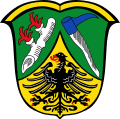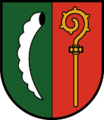Diocese of Chiemsee
The Bishopric of Chiemsee was founded in 1215/16, the (Fürst) Archbishop of Salzburg as metropolitans under standing suffragan of the Roman Catholic Church . As a result of secularization in Bavaria , the last bishop of the diocese resigned in 1808. With the Bavarian Concordat 1817/18, the diocese area became part of the archbishopric of Munich-Freising and Salzburg .
In 2009 it was rebuilt as a titular bishopric .
history
The Chiemsee diocese was founded in 1216 by the Archbishop of Salzburg , Eberhard von Regensberg . He followed the example of his predecessor, who had already established the Gurk diocese as an own diocese . In order to establish the diocese, Emperor Friedrich II first granted permission for Frauenchiemsee in 1213 and for Herrenchiemsee in 1215 . In the following year, Pope Innocent III also voted . the Archbishop's plan. The church of the Herrenchiemsee monastery was designated as the cathedral . The Augustinian canons of the Herrenchiemsee monastery formed the cathedral chapter . At its head stood a provost, who was also archdeacon of the diocese.
The creation of a further diocese was justified with the geographical expansion of the Archdiocese of Salzburg, which wanted its own bishop on site and at the same time tried to prevent the establishment of further regional dioceses.
The Bishop of Chiemsee was considered to be the feudal man of the Archbishop of Salzburg, who was nominated, confirmed, consecrated and invested by him. He thus acted as the Archbishop's personal auxiliary bishop , who could also assign him other tasks. Although bishop of his own diocese , the bishop mostly resided in Salzburg, where he had lived in the Chiemseehof since the beginning of the 14th century . In the cathedral, which was owned by the Augustinian Canons of Herrenchiemsee, he only had the bishop's throne, but had no other rights. Therefore, the parish of St. Johann in Tirol was incorporated into the episcopal cafeteria under Bishop Silvester Pflieger in 1446 and thus became an episcopal pastoral residence. As a result, the bishop now had a place within his diocese where he could exercise his official duties undisturbed and hold synods.
Although the bishops were able to expand their competencies in the 14th century, as self-bishops they always remained under the sovereignty of the metropolitan compared to other bishops . Since the bishop of Chiemsee was a vassal of the archbishop, he had a seat and vote in the Salzburg state parliaments, but not in the imperial council .
As a result of the secularization in Bavaria , the last bishop Sigmund Christoph von Zeil and Trauchburg renounced the office of bishop in 1808. With the Bavarian Concordat 1817/18, the Upper Bavarian part of the diocese became part of the new Archdiocese of Munich and Freising and the Tyrolean part of the Archbishopric of Salzburg, which had been robbed of its secular dominion .
Archdeaconate
When the diocese was founded, it was already determined that the rights of the Archdeacon of Chiemsee, who was also provost of the Augustinian canons and the island monastery, should not be curtailed. The bailiwick rights over the monastery were exercised by the Duchy of Bavaria , on whose territory the archdeaconate lay. The bishop and archdeacon were always in a conflict of competence, with Bavaria supporting the position of archdeacon. Only when the episcopal rights were strengthened by the Council of Trent did the bishop have full ordinarian power. A clear legal relationship was only created in 1613 when the archdeaconate was divided into an archiepiscopal part of Salzburg and an episcopal part of Chiemsee. With the establishment of a deanery in St. Johann, the influence of the provost was again reduced in 1621.
Expansion and organization
The area of the Diocese of Chiemsee was completely enclosed by the Archdiocese of Salzburg. The diocese borders ran from the Chiemsee over the Achental and the Leukental to the Pass Thurn in Tirol and over the eastern part of the Brixental and the Söllandl back to the Chiemsee.
When it was founded, the diocese consisted of ten parishes : Herrenchiemsee , Prien am Chiemsee , Eggstätt , Söllhuben , Grassau , Söll , Kirchdorf , St. Johann im Leukental , Brixen im Thale and St. Ulrich am Pillersee . From 1312 the parish of Brixen belonged politically to the archbishopric of Salzburg and from 1505 the parishes of Kirchdorf, St. Johann, Söll and St. Ulrich zu Tirol , so that the diocese finally extended over the spheres of influence of three sovereigns.
In addition, numerous other scattered goods came into the possession of the bishops of Chiemsee, such as the court brands Bischofshofen im Pongau (donated in 1215) or Koppl east of Salzburg.
In 1804 the Chiemsee diocese consisted of 16 vicariates , 10 curatios , 10 cooperatures , 11 chaplains and beneficiaries , a priest's house , a canon monastery and a Capuchin monastery . 38,818 Catholics lived in the then eleven parishes.
Titular diocese Chiemsee
In January 2009, the former diocese of Pope Benedict XVI. rebuilt as a titular bishopric . The titular seat is currently vacant .
Bishops
The list of the bishops of Chiemsee begins in 1216 with Rüdiger von Bergheim-Radeck and ends in 1808 with Sigmund Christoph von Waldburg zu Zeil and Trauchburg .
Coat of arms of the Diocese of Chiemsee
The coat of arms of the Diocese of Chiemsee is a split shield . In the right golden field a black, red-tongued eagle and in the left red field a silver Gothic pastoral . The black eagle on gold is an imperial eagle , which comes from the establishment permit for Frauen- and Herrenchiemsee by Emperor Friedrich II. 1213/15 (Chiemseeadler) .
The coat of arms of the diocese survived in some of the coats of arms of the former diocese area. The eagle was preserved in the coat of arms of the Traunstein district and the communities of Bischofshofen and Reit im Winkl , the bishop's staff is part of the coat of arms of the market town of St. Johann in Tirol as well as in Bischofshofen.
Eagle and crosier in the coat of arms of Bischofshofen
Coat of arms of the district of Traunstein : The Chiemseeadler top right
Coat of arms of the municipality of Reit im Winkl
The crosier in the coat of arms of St. Johann in Tirol
literature
- Max Fürst , The Chiemsee Diocese and its Bishops , 1927
- Engelbert Wallner, The Chiemsee Diocese in the Middle Ages (1215-1508) , 1967
- Johannes Graf von Moy, The Diocese of Chiemsee , 1982
- Erwin Naimer, The Diocese of Chiemsee in Modern Times , 1990
- Manfred Heim , bishop and archdeacon, spiritual skills in the Diocese of Chiemsee (1215–1817) , 1992
- Manfred Heim, Article Chiemsee, Diocese , in: Historisches Lexikon Bayerns, (available online)
- Erwin Gatz , The Bishops of the Holy Roman Empire , Vol. I, ISBN 3-428-10303-3 , p. 127
Web links
- Manfred Heim: Chiemsee, diocese . In: Historical Lexicon of Bavaria
- Entry for the Diocese of Chiemsee on catholic-hierarchy.org
- Entry for Diocese Chiemsee on catholic-hierarchy.org Titularbistum Chiemsee
- "The Chiemsee diocese was dissolved 200 years ago" (PDF file; 683 kB)
- Entry about the re-establishment of the Chiemsee diocese as a titular diocese on gcatholic.org (English)
- "Augustinian canons monastery Herrenchiemsee (from 1215 also cathedral monastery Chiemsee)" (GSN: 60130), in: Germania Sacra online
Individual evidence
- ↑ Peter Fischer: The Chiemsee diocese was dissolved 200 years ago; in: Between Kaiser, Kalkstein and Horn, contributions to local history by the Museum and Culture Association St. Johann in Tirol, No. 12, 2008
- ↑ Herrenchiemsee monastery and cathedral monastery. Festschrift of the Friends of Herrenchiemsee 1982, p. 7.





